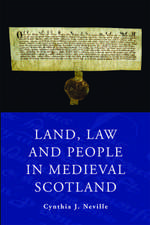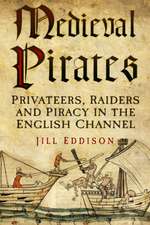The Medieval English Landscape, 1000-1540
Autor Dr Graeme J. Whiteen Limba Engleză Paperback – 5 sep 2012
| Toate formatele și edițiile | Preț | Express |
|---|---|---|
| Paperback (1) | 239.59 lei 6-8 săpt. | |
| Bloomsbury Publishing – 5 sep 2012 | 239.59 lei 6-8 săpt. | |
| Hardback (1) | 833.06 lei 6-8 săpt. | |
| Bloomsbury Publishing – 5 sep 2012 | 833.06 lei 6-8 săpt. |
Preț: 239.59 lei
Preț vechi: 273.75 lei
-12% Nou
Puncte Express: 359
Preț estimativ în valută:
45.84€ • 47.87$ • 37.94£
45.84€ • 47.87$ • 37.94£
Carte tipărită la comandă
Livrare economică 04-18 aprilie
Preluare comenzi: 021 569.72.76
Specificații
ISBN-13: 9781441135254
ISBN-10: 1441135251
Pagini: 296
Ilustrații: 40
Dimensiuni: 156 x 234 x 20 mm
Greutate: 0.45 kg
Ediția:New.
Editura: Bloomsbury Publishing
Colecția Bloomsbury Academic
Locul publicării:London, United Kingdom
ISBN-10: 1441135251
Pagini: 296
Ilustrații: 40
Dimensiuni: 156 x 234 x 20 mm
Greutate: 0.45 kg
Ediția:New.
Editura: Bloomsbury Publishing
Colecția Bloomsbury Academic
Locul publicării:London, United Kingdom
Caracteristici
Up-to-date and rich in original case studies and research.
Notă biografică
Graeme J. White is Emeritus Professor of Local History at the University of Chester, UK.His research interests include the reigns of King Stephen and King Henry II, and rural settlement and field systems. His publications include Restoration and Reform 1153-1165. He is also Editor of the journal, Cheshire History, and President of the Chester Society for Landscape History.
Cuprins
Notes on Measurements and other Conventions \ Abbreviations \ 1. Continuity and Change in the Medieval English Landscape \ 2. The Landscape of Farming and Hunting \ 3. The Landscape of Rural Settlement \ 4. The Landscape of Towns and Trade \ 5. The Landscape of Religion \ 6. The Landscape of Fortification \ 7. The End of the Medieval English Landscape? \ Bibliography \ Index
Recenzii
A clear account of what students of the subject have discovered, analysed, written and disagreed about in the last few years . . . the book is a nice record of the state of medieval landscape history in 2012 and thus of value as an introductory work . . . Recommended reading.
This book is a clearly written and highly accessible survey of the English medieval landscape which covers a range of topics including farming practices, settlement patterns, the development of towns and the role of religion . Throughout the book economic history is a useful reference point, and this is a factor in the use of the landscape and a measure of the success of farming and other activities. This book is accessibly and engagingly written, thoroughly referenced with an extensive bibliography, and forms an excellent gateway into the subject.
Discussion of fieldscapes, cultivation strips, open fields and other arrangements quickly opens up what for this reader is the lasting impression from the book overall, that is the great diversity of arrangements and practice across the country. Such is the wealth of detailed place-based and thematic studies now available and which the author brings into play (the twenty-three-page bibliography is a fine reference for anyone wishing to follow up some case studies), that broad generalising models of previous eras of scholarship are well superseded and the significance of immediate and local circumstances well recognised.
The text is fluent and very readable, drawing from disparate works by historians, archaeologists and geographers, and noting alternative views as well as consensus. It is supported by a helpful index.
Refreshing and informative . The book brings new insights to well-trodden debates, which are succinctly relayed . [A]n expertly-informed introductory text.
A well-written and engaging text which serves as an excellent introduction to its subject.
This book, which will appeal to both students and scholars alike, fills a gap in the subject dealing as it does with the full range of structures to be found in the medieval countryside. It reveals the complexity and diversity of England's farming landscapes, urban settlements and religious and defensive buildings. It provides an up-to-date and lively discussion of the development of the medieval landscape from the pre-Conquest period to the Reformation and will swiftly become a standard text for those interested in the subject.
Through skilful use of historical documents and context, Graeme White brings together the people and monuments of medieval England. Through this 500 year period of dramatic social, religious, political and military change, the narrative allows the reader to understand impact of new philosophies and pragmatic responses to circumstance on the physical fabric of the landscape of the day. This book is essential reading for historians and archaeologists alike.
Writing in a clear and engaging style that assumes no prior knowledge and yet never over simplifies, Graeme stalks the evidence that explains the character of the landscapes of farming, hunting, rural settlement, towns and trade, religion and fortification, Above all he asks over and again who was responsible for what we now see? He does not assume, as many landscape historians seem to have done, that the landscape just evolves: somebody, somewhere took decisions.
This book is a clearly written and highly accessible survey of the English medieval landscape which covers a range of topics including farming practices, settlement patterns, the development of towns and the role of religion . Throughout the book economic history is a useful reference point, and this is a factor in the use of the landscape and a measure of the success of farming and other activities. This book is accessibly and engagingly written, thoroughly referenced with an extensive bibliography, and forms an excellent gateway into the subject.
Discussion of fieldscapes, cultivation strips, open fields and other arrangements quickly opens up what for this reader is the lasting impression from the book overall, that is the great diversity of arrangements and practice across the country. Such is the wealth of detailed place-based and thematic studies now available and which the author brings into play (the twenty-three-page bibliography is a fine reference for anyone wishing to follow up some case studies), that broad generalising models of previous eras of scholarship are well superseded and the significance of immediate and local circumstances well recognised.
The text is fluent and very readable, drawing from disparate works by historians, archaeologists and geographers, and noting alternative views as well as consensus. It is supported by a helpful index.
Refreshing and informative . The book brings new insights to well-trodden debates, which are succinctly relayed . [A]n expertly-informed introductory text.
A well-written and engaging text which serves as an excellent introduction to its subject.
This book, which will appeal to both students and scholars alike, fills a gap in the subject dealing as it does with the full range of structures to be found in the medieval countryside. It reveals the complexity and diversity of England's farming landscapes, urban settlements and religious and defensive buildings. It provides an up-to-date and lively discussion of the development of the medieval landscape from the pre-Conquest period to the Reformation and will swiftly become a standard text for those interested in the subject.
Through skilful use of historical documents and context, Graeme White brings together the people and monuments of medieval England. Through this 500 year period of dramatic social, religious, political and military change, the narrative allows the reader to understand impact of new philosophies and pragmatic responses to circumstance on the physical fabric of the landscape of the day. This book is essential reading for historians and archaeologists alike.
Writing in a clear and engaging style that assumes no prior knowledge and yet never over simplifies, Graeme stalks the evidence that explains the character of the landscapes of farming, hunting, rural settlement, towns and trade, religion and fortification, Above all he asks over and again who was responsible for what we now see? He does not assume, as many landscape historians seem to have done, that the landscape just evolves: somebody, somewhere took decisions.












